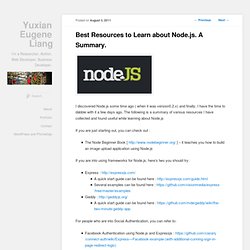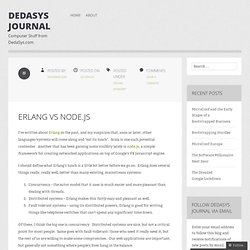

Best Resources to Learn about Node.js. A Summary. I discovered Node.js some time ago ( when it was version0.2.x) and finally, I have the time to dabble with it a few days ago.

The following is a summary of various resources I have collected and found useful while learning about Node.js If you are just starting out, you can check out : The Node Beginner Book [ ] – it teaches you how to build an image upload application using Node.js If you are into using frameworks for Node.js, here’s two you should try: For people who are into Social Authentication, you can refer to: Need various database support? For people who are slightly more advanced. Node.js. Why Everyone Is Talking About Node. The Web Development Series is supported by Rackspace, the better way to do hosting.

Learn more about Rackspace's hosting solutions here. On the 20th floor of a San Francisco skyscraper, a handful of developers are working on a new technology that's changing the way real-time web apps are built and how they scale. This technology, called Node.js, is being hailed as "the new Ruby on Rails" by some in the developer community. But it's not a magic bullet, nor is it appropriate for all programming scenarios. Joyent, an SF-based cloud software company, is sponsoring the growth and development of Node. In the process, we learned a lot about how and why Node works for the real-time web — and how Node is changing the way the developer community creates the Internet as we know it.
What Makes Node Different Node had a watershed year in 2010, and it's shaping up to be as popular as Ruby on Rails among developers. Then there's the community. Node's Explosive Growth Node for Real-Time Voice. How To Node - NodeJS. Erlang vs node.js. I've written about Erlang in the past, and my suspicion that, soon or later, other languages/systems will come along and "eat its lunch".

Scala is one such potential contender. Another that has been gaining some visiblity lately is node.js, a simple framework for creating networked applications on top of Google's V8 Javascript engine. I should define what Erlang's lunch is a little bit better before we go on. Erlang does several things really, really well; better than many existing, mainstream systems: Concurrency – the Actor model that it uses is much easier and more pleasant than dealing with threads. Of these, I think the big one is concurrency. How does Erlang do "concurrency"? No other system that I know of has such a focus on being non-blocking, and node.js is no exception: a while(true) loop is perfectly capable of wedging the system.
Like this: Like Loading... Streaming file uploads with node.js » Debuggable Ltd. Update: I just updated the code so it works with node v0.1.18.

Not excited by hello world in node.js? No problem. Let's say you are a startup focusing on upload technology and you want the maximum level of control for your file uploads. In our case that means having the ability to directly interact with the multipart data stream as it comes in (so we can abort the upload if something isn't right, - beats the hell out of letting the user wait an hour to tell him after the upload has finished). Here is a complete example on how to accomplish this in node.js (you'll need the bleeding edge git version): var http = require('http');var multipart = require('multipart');var sys = require('sys'); function upload_file(req, res) { req.setBodyEncoding('binary'); sys.print("Uploading "+mb+"mb ("+progress+"%)\015"); The code is rather straight forward.
Next we create a server listening on port 8000 that dispatches incoming requests to one of our 3 functions: display_form, upload_file or show_404.